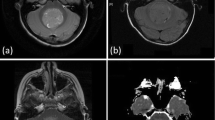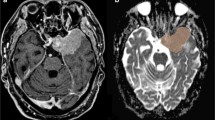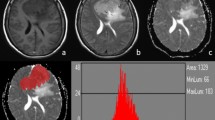Abstract
A subset of benign (WHO grade I) skull base meningiomas show early progression/recurrence (P/R) in the first years after surgical resection. Besides, complete surgical resection may be difficult to achieve safely in skull base meningiomas due to complex neurovascular structures. The one main challenge in the treatment of skull base meningiomas is to determine factors that correlate with P/R. We retrospectively investigated the preoperative CT and MR imaging features for the prediction of P/R in skull base meningiomas, with emphasis on quantitative ADC values. Only patients had postoperative MRI follow-ups for more than 1 year (at least every 6 months) were included. From October 2006 to December 2015, total 73 patients diagnosed with benign (WHO grade I) skull base meningiomas were included (median follow-up time 41 months), and 17 (23.3%) patients had P/R (median time to P/R 28 months). Skull base meningiomas with spheno-orbital location, adjacent bone invasion, high DWI, and lower ADC value/ratio were significantly associated with P/R (P < 0.05). The cut-off points of ADC value and ADC ratio for prediction of P/R are 0.83 × 10− 3 mm2/s and 1.09 respectively, with excellent area under curve (AUC) values (0.86 and 0.91) (P < 0.05). In multivariate logistic regression, low ADC values (< 0.83 × 10− 3 mm2/s) and adjacent bone invasion are high-risk factors of P/R (P < 0.05), with odds ratios of 31.53 and 17.59 respectively. The preoperative CT and MRI features for prediction of P/R offered clinically vital information for the planning of treatment in skull base meningiomas.


Similar content being viewed by others
References
Wiemels J, Wrensch M, Claus EB (2010) Epidemiology and etiology of meningioma. J Neuro-Oncol 99:307–314. https://doi.org/10.1007/s11060-010-0386-3
Mansouri A, Klironomos G, Taslimi S, Kilian A, Gentili F, Khan OH, Aldape K, Zadeh G (2016) Surgically resected skull base meningiomas demonstrate a divergent postoperative recurrence pattern compared with non-skull base meningiomas. J Neurosurg 125:431–440. https://doi.org/10.3171/2015.7.jns15546
Louis DN, Ohgaki H, Wiestler OD, Cavenee WK, Burger PC, Jouvet A, Scheithauer BW, Kleihues P (2007) The 2007 WHO classification of tumours of the central nervous system. Acta Neuropathol 114:97–109. https://doi.org/10.1007/s00401-007-0243-4
Perry A, Stafford SL, Scheithauer BW, Suman VJ, Lohse CM (1997) Meningioma grading: an analysis of histologic parameters. Am J Surg Pathol 21:1455–1465
Maillo A, Orfao A, Espinosa AB, Sayagues JM, Merino M, Sousa P, Lara M, Tabernero MD (2007) Early recurrences in histologically benign/grade I meningiomas are associated with large tumors and coexistence of monosomy 14 and del(1p36) in the ancestral tumor cell clone. Neuro-oncology 9:438–446. https://doi.org/10.1215/15228517-2007-026
Ildan F, Erman T, Gocer AI, Tuna M, Bagdatoglu H, Cetinalp E, Burgut R (2007) Predicting the probability of meningioma recurrence in the preoperative and early postoperative period: a multivariate analysis in the midterm follow-up. Skull Base 17:157–171. https://doi.org/10.1055/s-2007-970554
Simpson D (1957) The recurrence of intracranial meningiomas after surgical treatment. J Neurol Neurosurg Psychiatr 20:22–39
Nanda A, Vannemreddy P (2008) Recurrence and outcome in skull base meningiomas: do they differ from other intracranial meningiomas? Skull Base 18: 243–252 https://doi.org/10.1055/s-2007-1016956
Black PM, Villavicencio AT, Rhouddou C, Loeffler JS (2001) Aggressive surgery and focal radiation in the management of meningiomas of the skull base: preservation of function with maintenance of local control. Acta Neurochirurgica 143:555–562
Kreil W, Luggin J, Fuchs I, Weigl V, Eustacchio S, Papaefthymiou G (2005) Long term experience of gamma knife radiosurgery for benign skull base meningiomas. J Neurol Neurosurg Psychiatr 76:1425–1430. https://doi.org/10.1136/jnnp.2004.049213
Sekhar LN, Juric-Sekhar G, Brito da Silva H, Pridgeon JS (2015) Skull base meningiomas: aggressive resection. Neurosurgery 62 Suppl 1: 30–49 https://doi.org/10.1227/neu.0000000000000803
Hwang WL, Marciscano AE, Niemierko A, Kim DW, Stemmer-Rachamimov AO, Curry WT, Barker FG, Martuza RL, Loeffler JS, Oh KS, Shih HA, Larvie M (2016) Imaging and extent of surgical resection predict risk of meningioma recurrence better than WHO histopathological grade. Neuro-oncology 18: 863–872 https://doi.org/10.1093/neuonc/nov285
Maclean J, Fersht N, Short S (2014) Controversies in radiotherapy for meningioma. Clin Oncol 26: 51–64 https://doi.org/10.1016/j.clon.2013.10.001
Walker AJ, Ruzevick J, Malayeri AA, Rigamonti D, Lim M, Redmond KJ, Kleinberg L (2014) Postradiation imaging changes in the CNS: how can we differentiate between treatment effect and disease progression? Future Oncol 10:1277–1297. https://doi.org/10.2217/fon.13.271
Miyatake S, Kawabata S, Nonoguchi N, Yokoyama K, Kuroiwa T, Matsui H, Ono K (2009) Pseudoprogression in boron neutron capture therapy for malignant gliomas and meningiomas. Neuro-oncology 11:430–436. https://doi.org/10.1215/15228517-2008-107
Hallock A, Bauman G (2012) Transient radiographic early enhancement after radiotherapy for meningioma. Can J Neurol Sci 39:99–101
Server A, Kulle B, Maehlen J, Josefsen R, Schellhorn T, Kumar T, Langberg CW, Nakstad PH (2009) Quantitative apparent diffusion coefficients in the characterization of brain tumors and associated peritumoral edema. Acta Radiol 50: 682–689 https://doi.org/10.1080/02841850902933123
Toh CH, Castillo M, Wong AM, Wei KC, Wong HF, Ng SH, Wan YL (2008) Primary cerebral lymphoma and glioblastoma multiforme: differences in diffusion characteristics evaluated with diffusion tensor imaging. AJNR Am J Neuroradiol 29:471–475. https://doi.org/10.3174/ajnr.A0872
Landis JR, Koch GG (1977) The measurement of observer agreement for categorical data. Biometrics 33:159–174
Nagar VA, Ye JR, Ng WH, Chan YH, Hui F, Lee CK, Lim CC (2008) Diffusion-weighted MR imaging: diagnosing atypical or malignant meningiomas and detecting tumor dedifferentiation. AJNR Am J Neuroradiol 29:1147–1152. https://doi.org/10.3174/ajnr.A0996
Tang Y, Dundamadappa SK, Thangasamy S, Flood T, Moser R, Smith T, Cauley K, Takhtani D (2014) Correlation of apparent diffusion coefficient with Ki-67 proliferation index in grading meningioma. AJR Am J Roentgenol 202:1303–1308. https://doi.org/10.2214/ajr.13.11637
Clark VE, Erson-Omay EZ, Serin A, Yin J, Cotney J, Ozduman K, Avsar T, Li J, Murray PB, Henegariu O, Yilmaz S, Gunel JM, Carrion-Grant G, Yilmaz B, Grady C, Tanrikulu B, Bakircioglu M, Kaymakcalan H, Caglayan AO, Sencar L, Ceyhun E, Atik AF, Bayri Y, Bai H, Kolb LE, Hebert RM, Omay SB, Mishra-Gorur K, Choi M, Overton JD, Holland EC, Mane S, State MW, Bilguvar K, Baehring JM, Gutin PH, Piepmeier JM, Vortmeyer A, Brennan CW, Pamir MN, Kilic T, Lifton RP, Noonan JP, Yasuno K, Gunel M (2013) Genomic analysis of non-NF2 meningiomas reveals mutations in TRAF7, KLF4, AKT1, and SMO. Science 339: 1077–1080 https://doi.org/10.1126/science.1233009
McGovern SL, Aldape KD, Munsell MF, Mahajan A, DeMonte F, Woo SY (2010) A comparison of World Health Organization tumor grades at recurrence in patients with non-skull base and skull base meningiomas. J Neurosurg 112:925–933. https://doi.org/10.3171/2009.9.jns09617
Sade B, Chahlavi A, Krishnaney A, Nagel S, Choi E, Lee JH (2007) World Health Organization Grades II and III meningiomas are rare in the cranial base and spine. Neurosurgery 61:1194–1198. https://doi.org/10.1227/01.neu.0000306097.38141.65 discussion 1198
Brastianos PK, Horowitz PM, Santagata S, Jones RT, McKenna A, Getz G, Ligon KL, Palescandolo E, Van Hummelen P, Ducar MD, Raza A, Sunkavalli A, Macconaill LE, Stemmer-Rachamimov AO, Louis DN, Hahn WC, Dunn IF, Beroukhim R (2013) Genomic sequencing of meningiomas identifies oncogenic SMO and AKT1 mutations. Nat Genet 45:285–289. https://doi.org/10.1038/ng.2526
Mathiesen T, Lindquist C, Kihlstrom L, Karlsson B (1996) Recurrence of cranial base meningiomas. Neurosurgery 39:2–7 discussion 8–9
Kallio M, Sankila R, Hakulinen T, Jaaskelainen J (1992) Factors affecting operative and excess long-term mortality in 935 patients with intracranial meningioma. Neurosurgery 31:2–12
Olmsted WW, McGee TP (1977) Prognosis in meningioma through evaluation of skull bone patterns. Radiology 123:375–377. https://doi.org/10.1148/123.2.375
Voss KM, Spille DC, Sauerland C, Suero Molina E, Brokinkel C, Paulus W, Stummer W, Holling M, Jeibmann A, Brokinkel B (2017) The Simpson grading in meningioma surgery: does the tumor location influence the prognostic value? J Neuro-Oncol 133:641–651. https://doi.org/10.1007/s11060-017-2481-1
Di Maio S, Ramanathan D, Garcia-Lopez R, Rocha MH, Guerrero FP, Ferreira M Jr, Sekhar LN (2012) Evolution and future of skull base surgery: the paradigm of skull base meningiomas. World Neurosurg 78:260–275. https://doi.org/10.1016/j.wneu.2011.09.004
Igaki H, Maruyama K, Koga T, Murakami N, Tago M, Terahara A, Shin M, Nakagawa K, Ohtomo K (2009) Stereotactic radiosurgery for skull base meningioma. Neurol Medico-chir 49:456–461
Kaur G, Sayegh ET, Larson A, Bloch O, Madden M, Sun MZ, Barani IJ, James CD, Parsa AT (2014) Adjuvant radiotherapy for atypical and malignant meningiomas: a systematic review. Neuro-oncology 16:628–636. https://doi.org/10.1093/neuonc/nou025
Funding
No funding support.
Author information
Authors and Affiliations
Corresponding author
Ethics declarations
Conflict of interest
The authors declare that they have no conflict of interest.
Electronic supplementary material
Below is the link to the electronic supplementary material.
Rights and permissions
About this article
Cite this article
Ko, CC., Lim, SW., Chen, TY. et al. Prediction of progression in skull base meningiomas: additional benefits of apparent diffusion coefficient value. J Neurooncol 138, 63–71 (2018). https://doi.org/10.1007/s11060-018-2769-9
Received:
Accepted:
Published:
Issue Date:
DOI: https://doi.org/10.1007/s11060-018-2769-9




